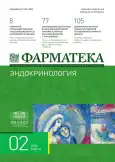Использование дулаглутида в реальной клинической практике у больных сахарным диабетом 2 типа в Москве
- Авторы: Анциферов М.Б.1, Анциферова Д.М.1,2, Котешкова О.М.1, Демидов Н.А.3
-
Учреждения:
- Эндокринологический диспансер ДЗМ
- Российская медицинская академия непрерывного профессионального образования
- Городская больница г. Московский ДЗМ
- Выпуск: Том 31, № 2 (2024)
- Страницы: 77-84
- Раздел: Оригинальные статьи
- Статья опубликована: 23.05.2024
- URL: https://journals.eco-vector.com/2073-4034/article/view/632402
- DOI: https://doi.org/10.18565/pharmateca.2024.2.77-84
- ID: 632402
Цитировать
Полный текст
Аннотация
Цель исследования: оценить эффективность использования дулаглутида в реальной клинической практике для больных сахарным диабетом 2 типа (СД2) в Москве.
Методы. Для оценки основных показателей больных СД2, использующих в терапии дулаглутид, была сформирована выборка из Московского сегмента Федерального регистра сахарного диабета (ФРСД) по состоянию на 14.02.2024. Для оценки эффективности терапии дулаглутидом в течение 5 лет наблюдения дополнительно была сформирована выборка пациентов из Московского сегмента ФРСД, начавших лечение дулаглутидом в 2018 г.
Результаты. При оценке динамики показателей контроля углеводного обмена более чем за 5-летний период наблюдения (2018–01.02.2024) отмечена тенденция к снижению уровня HbA1c с 7,3 до 7,0% (p>0,05). В подгруппе пациентов, не получавших инсулинотерапии, продемонстрировано статистически значимое снижение уровня HbA1c с 7,3 до 6,7% (p=0,04), на инсулинотерапии не было отмечено статистически значимого изменения HbA1c (7,5±1,1 против 7,7±1,1%; p>0,05). При оценке динамики отмечено статистически значимое снижение массы тела со 102,9±21,8 до 98,4±19,6 кг, снижение индекса массы тела (ИМТ) с 35,6 до 33,5 кг/м2 (p<0,05) в первую очередь за счет пациентов, не получавших инсулинотерапии (p<0,05). У пациентов на инсулинотерапии не отмечено статистически значимых различий в динамике массы тела и ИМТ.
Выводы. Использование дулаглутида в реальной клинической практике демонстрирует длительное удержание показателей гликемического контроля в рамках целевых значений или близко к ним и статистически значимое снижение массы тела и ИМТ. Наибольшая эффективность в достижении показателей гликемического контроля, снижении массы тела и ИМТ достигнута в когорте больных СД2, не получающих препаратов инсулина.
Полный текст
Об авторах
М. Б. Анциферов
Эндокринологический диспансер ДЗМ
Email: koala58@mail.ru
ORCID iD: 0000-0002-9944-2997
SPIN-код: 1035-4773
Россия, Москва
Д. М. Анциферова
Эндокринологический диспансер ДЗМ; Российская медицинская академия непрерывного профессионального образования
Email: koala58@mail.ru
ORCID iD: 0000-0002-3920-5914
Россия, Москва; Москва
О. М. Котешкова
Эндокринологический диспансер ДЗМ
Автор, ответственный за переписку.
Email: koala58@mail.ru
ORCID iD: 0000-0001-8428-4116
SPIN-код: 6141-1224
к.м.н., зав. отделением обучения и лечения диабета
Россия, МоскваН. А. Демидов
Городская больница г. Московский ДЗМ
Email: koala58@mail.ru
ORCID iD: 0000-0001-8289-0032
SPIN-код: 7715-4508
Россия, Москва
Список литературы
- www. diabetesatlas.org. Facts & figures (idf.org) URL: https://www.idf.org/aboutdiabetes/what-is-diabetes/facts-figures.html
- Анциферов М.Б., Демидов Н.А., Калашникова М.Ф. и др. Динамика основных эпидемиологических показателей у пациентов с сахарным диабетом, проживающих в Москве (2013–2018). Сахарный диабет. 2020;23(2):113–24. [Antsiferov M.B., Demidov N.A., Kalashnikova M.F. and others. Dynamics of the main epidemiological indicators in patients with diabetes mellitus living in Moscow (2013–2018). Diabetes mellitus. 2020;23(2):113–24. (In Russ.)]. doi: 10.14341/DM11374.
- American Diabetes Association. Diab Care. 2023;46(Suppl. 1):S1–298.
- Дедов И.И., Шестакова М.В., Майоров А.Ю. Алгоритмы диагностики и лечения сахарного диабета. Сахарный диабет. 2023;26(Suppl. 2):1–231. [Dedov I.I., Shestakova M.V., Mayorov A.Yu. Algorithms for the diagnosis and treatment of diabetes mellitus. Diabetes mellitus. 2023;26(Suppl. 2):1–231. (In Russ.)]. doi: 10.14341/DM13042.
- Nauck M.A., Quast D.R., Wefers J., Meier J.J. GLP-1 receptor agonists in the treatment of type 2 diabetes–state-of-the-art. Mol Metab. 2021;46:101102. doi: 10.1016/j.molmet.2020.101102.
- Shyangdan D.S., Royle P., Clar C., et al. Glucagon-like peptide analogues for type 2 diabetes malloitus. Cochrane Database Syst. Rev. 2011;2011:CD006423. doi: 10.1002/14651858.CD006423.pub2.
- Nauck M. Incretin therapies: highlighting common features and differences in the modes of action of glucagon-like peptide-1 receptor agonists and dipeptidyl peptidase-4 inhibitors. Diab Obes Metab. 2016;18(3):203–16. doi: 10.1111/dom.12591.
- Frias J.P., Bonora E., Nevarez Ruiz L., et al. Efficacy and safety of dulaglutide 3.0 mg and 4.5 mg versus dulaglutide 1.5 mg in metformin-treated patients with type 2 diabetes in a randomized controlled trial (AWARD-11). Diab Care. 2021;44:765–73. Doi: 10.2337/ dc20-1473.
- Gerstein H.C., Colhoun H.M., Dagenais G.R., et al. Dulaglutide and cardiovascular outcomes in type 2 diabetes (REWIND): a double-blind, randomised placebo-controlled trial. Lancet. 2019;394(10193):121–30. doi: 10.1016/S0140-6736(19)31149-3.
- Botros F.T., Gerstein H.C., Malik R., et al. Dulaglutide and Kidney Function-Related Outcomes in Type 2 Diabetes: A REWIND Post Hoc Analysis. Diab Care. 2023;46(8):1524–30. doi: 10.2337/dc23-0231.
Дополнительные файлы












